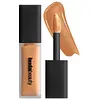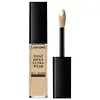Huda Beauty #FauxFilter Luminous Matte Concealer Versus Lancôme Teint Idôle Ultra Wear All Over Concealer
What's inside
What's inside
 Key Ingredients
Key Ingredients

 Benefits
Benefits

 Concerns
Concerns

 Ingredients Side-by-side
Ingredients Side-by-side

Water
Skin ConditioningCyclopentasiloxane
EmollientPropanediol
SolventDimethicone
EmollientPhenyl Trimethicone
Skin ConditioningTrimethylsiloxysilicate
EmollientLauryl PEG-9 Polydimethylsiloxyethyl Dimethicone
Skin ConditioningPhenylisopropyl Dimethicone
Skin ConditioningCaprylyl Methicone
Skin ConditioningHdi/Trimethylol Hexyllactone Crosspolymer
C20-24 Alkyl Dimethicone
Skin ConditioningSynthetic Fluorphlogopite
Prunus Amygdalus Dulcis Oil
Skin ConditioningTocopherol
AntioxidantTocopheryl Acetate
AntioxidantEthylhexylglycerin
Skin ConditioningSodium Chloride
MaskingAluminum Hydroxide
EmollientHydrogen Dimethicone
Isododecane
EmollientTalc
AbrasiveDimethicone Crosspolymer
Emulsion StabilisingSodium Gluconate
Skin ConditioningDimethicone/PEG-10/15 Crosspolymer
Disteardimonium Hectorite
StabilisingSilica
AbrasiveTin Oxide
AbrasivePhenoxyethanol
PreservativeCI 77491
Cosmetic ColorantCI 77492
Cosmetic ColorantCI 77499
Cosmetic ColorantCI 77891
Cosmetic ColorantWater, Cyclopentasiloxane, Propanediol, Dimethicone, Phenyl Trimethicone, Trimethylsiloxysilicate, Lauryl PEG-9 Polydimethylsiloxyethyl Dimethicone, Phenylisopropyl Dimethicone, Caprylyl Methicone, Hdi/Trimethylol Hexyllactone Crosspolymer, C20-24 Alkyl Dimethicone, Synthetic Fluorphlogopite, Prunus Amygdalus Dulcis Oil, Tocopherol, Tocopheryl Acetate, Ethylhexylglycerin, Sodium Chloride, Aluminum Hydroxide, Hydrogen Dimethicone, Isododecane, Talc, Dimethicone Crosspolymer, Sodium Gluconate, Dimethicone/PEG-10/15 Crosspolymer, Disteardimonium Hectorite, Silica, Tin Oxide, Phenoxyethanol, CI 77491, CI 77492, CI 77499, CI 77891
Water
Skin ConditioningUndecane
EmollientDimethicone
EmollientGlycerin
HumectantTridecane
PerfumingPolyglyceryl-4 Isostearate
EmulsifyingPentylene Glycol
Skin ConditioningCetyl PEG/PPG-10/1 Dimethicone
EmulsifyingHexyl Laurate
EmollientMagnesium Sulfate
Disteardimonium Hectorite
StabilisingRosa Gallica Flower Extract
AstringentHelianthus Annuus Seed Oil
EmollientMoringa Oleifera Seed Extract
Skin ConditioningNymphaea Alba Flower Extract
Skin ConditioningIsobutane
Sorbitol
HumectantTrihydroxystearin
Skin ConditioningCellulose Gum
Emulsion StabilisingAluminum Hydroxide
EmollientDisodium Phosphate
BufferingDisodium Stearoyl Glutamate
CleansingPropanediol
SolventPropylene Glycol
HumectantCitric Acid
BufferingAcetylated Glycol Stearate
EmollientEthylhexylglycerin
Skin ConditioningAcrylonitrile/Methyl Methacrylate/Vinylidene Chloride Copolymer
Tocopherol
AntioxidantPentaerythrityl Tetra-Di-T-Butyl Hydroxyhydrocinnamate
AntioxidantPhenoxyethanol
PreservativeWater, Undecane, Dimethicone, Glycerin, Tridecane, Polyglyceryl-4 Isostearate, Pentylene Glycol, Cetyl PEG/PPG-10/1 Dimethicone, Hexyl Laurate, Magnesium Sulfate, Disteardimonium Hectorite, Rosa Gallica Flower Extract, Helianthus Annuus Seed Oil, Moringa Oleifera Seed Extract, Nymphaea Alba Flower Extract, Isobutane, Sorbitol, Trihydroxystearin, Cellulose Gum, Aluminum Hydroxide, Disodium Phosphate, Disodium Stearoyl Glutamate, Propanediol, Propylene Glycol, Citric Acid, Acetylated Glycol Stearate, Ethylhexylglycerin, Acrylonitrile/Methyl Methacrylate/Vinylidene Chloride Copolymer, Tocopherol, Pentaerythrityl Tetra-Di-T-Butyl Hydroxyhydrocinnamate, Phenoxyethanol
 Reviews
Reviews

Ingredients Explained
These ingredients are found in both products.
Ingredients higher up in an ingredient list are typically present in a larger amount.
Aluminum Hydroxide is a form of aluminum. It can be naturally found in nature as the mineral gibbsite. In cosmetics, Aluminum Hydroxide is used as a colorant, pH adjuster, and absorbent.
As a colorant, Aluminum Hydroxide may add opacity, or reduce the transparency. Aluminum hydroxide is contains both basic and acidic properties.
According to manufacturers, this ingredient is an emollient and humectant. This means it helps hydrate the skin.
In medicine, this ingredient is used to help relieve heartburn and help heal ulcers.
There is currently no credible scientific evidence linking aluminum hydroxide in cosmetics to increased cancer risk.
Major health organizations allow the use of aluminum hydroxide in personal care products and have not flagged it as a carcinogenic risk at typical usage levels.
Learn more about Aluminum HydroxideDimethicone is a type of synthetic silicone created from natural materials such as quartz.
What it does:
Dimethicone comes in different viscosities:
Depending on the viscosity, dimethicone has different properties.
Ingredients lists don't always show which type is used, so we recommend reaching out to the brand if you have questions about the viscosity.
This ingredient is unlikely to cause irritation because it does not get absorbed into skin. However, people with silicone allergies should be careful about using this ingredient.
Note: Dimethicone may contribute to pilling. This is because it is not oil or water soluble, so pilling may occur when layered with products. When mixed with heavy oils in a formula, the outcome is also quite greasy.
Learn more about DimethiconeDisteardimonium Hectorite comes from the clay mineral named hectorite. It is used to add thickness to a product.
It can also help stabilize a product by helping to disperse other ingredients.
Hectorite is a rare, white clay mineral.
Learn more about Disteardimonium HectoriteEthylhexylglycerin (we can't pronounce this either) is commonly used as a preservative and skin softener. It is derived from glyceryl.
You might see Ethylhexylglycerin often paired with other preservatives such as phenoxyethanol. Ethylhexylglycerin has been found to increase the effectiveness of these other preservatives.
Phenoxyethanol is a preservative that has germicide, antimicrobial, and aromatic properties. Studies show that phenoxyethanol can prevent microbial growth. By itself, it has a scent that is similar to that of a rose.
It's often used in formulations along with Caprylyl Glycol to preserve the shelf life of products.
Propanediol is an all-star ingredient. It softens, hydrates, and smooths the skin.
It’s often used to:
Propanediol is not likely to cause sensitivity and considered safe to use. It is derived from corn or petroleum with a clear color and no scent.
Learn more about PropanediolTocopherol (also known as Vitamin E) is a common antioxidant used to help protect the skin from free-radicals and strengthen the skin barrier. It's also fat soluble - this means our skin is great at absorbing it.
Vitamin E also helps keep your natural skin lipids healthy. Your lipid skin barrier naturally consists of lipids, ceramides, and fatty acids. Vitamin E offers extra protection for your skin’s lipid barrier, keeping your skin healthy and nourished.
Another benefit is a bit of UV protection. Vitamin E helps reduce the damage caused by UVB rays. (It should not replace your sunscreen). Combining it with Vitamin C can decrease sunburned cells and hyperpigmentation after UV exposure.
You might have noticed Vitamin E + C often paired together. This is because it is great at stabilizing Vitamin C. Using the two together helps increase the effectiveness of both ingredients.
There are often claims that Vitamin E can reduce/prevent scarring, but these claims haven't been confirmed by scientific research.
Learn more about TocopherolWater. It's the most common cosmetic ingredient of all. You'll usually see it at the top of ingredient lists, meaning that it makes up the largest part of the product.
So why is it so popular? Water most often acts as a solvent - this means that it helps dissolve other ingredients into the formulation.
You'll also recognize water as that liquid we all need to stay alive. If you see this, drink a glass of water. Stay hydrated!
Learn more about Water